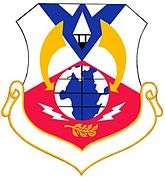6th Air Division
The 6th Air Division is an inactive United States Air Force unit. Its last assignment was with the Thirteenth Air Force, based at Clark Air Base, Philippines. It was inactivated on 15 December 1969.
6th Air Division
 | |
|---|---|
| Active | 1940–1941; 1942–1943; 1946–1948; 1951–1966; 1968–1969 |
| Country | |
| Branch | |
| Equipment | see "Aircraft / Missiles / Space Vehicles" section below |
| Insignia | |
| 6th Air Division emblem (approved 5 October 1955)[1] |  |
Heraldry
On a shield per chevron argent and gules, in chief, a stylized silhouetted jet aircraft, issuing from chief, nose toward base azure; in base a sphere with land areas of the first and water areas of the third, grid lines black, over a branch of olive or, between two lightning bolts argent; superimposed overall and flanking the dexter and sinister, two stylized arrows or. (Approved 5 October 1955)
History
Established as a pursuit wing in 1940, under Northeast Air District (later First Air Force). Deployed to the European Theater of Operations in the summer of 1942, the 6th Fighter Wing was a training organization for VIII Fighter Command in England during 1942/43 where it trained replacement pilots for fighter organizations. After the war, it served in the Canal Zone as part of the defense forces of the Panama Canal
Being redesignated as an Air Division in 1951, the 6th Air Division was an intermediate command echelon of Strategic Air Command, performing, organizing, and training assigned units for sustained long–range offensive bombardment and air-to-air refueling operations around the world.
Inactivated by SAC with the closure of Dow Air Force Base in 1966, the unit was reactivated under Thirteenth Air Force in the Philippines as a theater transport command and control organization, supporting US forces in the Vietnam War. Units under the division's control participated in Arc Light missions and controlled aircraft that flew weather reconnaissance missions in Southeast Asia.[1]
Inactivated in 1969 due to budget restraints.
Lineage
- Established as the 6th Pursuit Wing on 19 October 1940
- Activated on 18 December 1940
- Inactivated on 7 December 1941
- Redesignated 6th Fighter Wing on 30 May 1942
- Activated on 7 June 1942
- Disestablished on 13 September 1943
- Reestablished on 5 August 1946
- Activated on 25 August 1946
- Inactivated on 28 July 1948
- Redesignated 6th Air Division on 1 February 1951
- Organized on 10 February 1951
- Discontinued on 16 June 1952
- Activated on 16 June 1952
- Discontinued and inactivated on 2 July 1966
- Activated on 5 July 1968
- Organized on 1 August 1968
- Inactivated on 15 December 1969[1]
Assignments
- GHQ Air Force, 18 December 1940 – 7 December 1941
- Apparently further assigned to: Northeast Air District, later 1st Air Force, 16 January 1941
- Apparently further assigned to: I Interceptor Command, 5 June – 7 December 1941
- VIII Fighter Command, 7 June 1942 – 13 September 1943 (attached to I Fighter Command until c. 5 August 1942)
- Caribbean Air Command, 25 August 1946 – 28 July 1948
- Second Air Force, 10 February 1951 – 16 June 1952
- Second Air Force, 16 June 1952
- Eighth Air Force, 1 January 1959 – 2 July 1966
- Pacific Air Forces, 5 July 1968 (not organized)
- Thirteenth Air Force, 1 August 1968 – 15 December 1969[1]
Components
|
Wings
Groups
|
Squadrons
|
Stations
- Selfridge Field, Michigan, 18 December 1940 – 7 December 1941
- Olmsted Field, Pennsylvania, 7 June-c. 4 August 1942
- RAF Bushey Hall (AAF-341), England, c. 16 August 1942
- RAF Atcham (AAF-342), England, c. 24 August 1942 – 13 September 1943
- Howard Field, Panama Canal Zone, 25 August 1946 – 28 July 1948
- MacDill Air Force Base, Florida, 10 February 1951
- Dow Air Force Base, Maine, 1 April 1961 – 2 July 1966
- Clark Air Base, Philippines, 1 August 1968 – 15 December 1969[1]
Aircraft / Missiles / Space Vehicles
|
|
References
Notes
- "Factsheet 6 Air Division". Air Force Historical Research Agency. 4 October 2007. Archived from the original on 30 October 2012. Retrieved 5 March 2014.
Bibliography
![]()
- Maurer, Maurer, ed. (1983) [1961]. Air Force Combat Units of World War II (PDF) (reprint ed.). Washington, DC: Office of Air Force History. ISBN 0-912799-02-1. LCCN 61060979.
- Ravenstein, Charles A. (1984). Air Force Combat Wings, Lineage & Honors Histories 1947-1977. Washington, DC: Office of Air Force History. ISBN 0-912799-12-9.

.jpg)